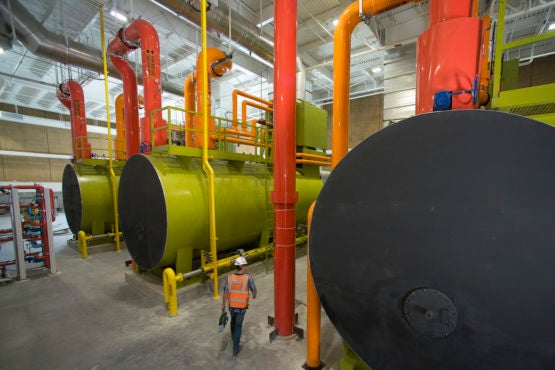May 7, 2019
Cities can follow Stanford’s energy makeover to cut emissions of carbon dioxide affordably, new study finds
With a few changes to its existing energy operations, Stanford could further reduce its carbon footprint and costs in a model that other large campuses, towns and even cities can benefit from, a new study finds.
By Vincent Xia
Over the past several years, Stanford transformed its energy infrastructure by electrifying its heating system, replacing its gas-fired power plant with grid power, creating a unique system to recover heat, building massive tanks to store hot and cold water, and building a solar power plant. The Stanford Energy System Innovations project cut the campus’s total greenhouse gas emissions 68 percent and is lowering the system’s operating costs by $425 million over 35 years.

A new study indicates Stanford’s Central Energy Facility can serve as a model for other large campuses and communities seeking to cut carbon dioxide emissions affordably. (Image credit: L.A. Cicero)
Now, a new study, published in Energy & Environmental Science, lays out a roadmap for expanding those benefits at Stanford and translating them to other campuses and communities. The study’s approach, if broadly adopted, could help maintain the reliability of electricity grids increasingly dependent on intermittent renewables.
Stanford’s thermal storage tanks can hold up to a half-day’s supply of heating and cooling, which means they could be used like batteries to store excess energy and reduce carbon emissions. The authors find that the campus could maximize its purchases of electricity at times of day when the grid is flush with renewable power, using the electricity to heat and chill water especially during those hours. By 2025, the study shows, this protocol could reduce the university’s carbon emissions from heating and cooling an additional 40 percent.
“Large-scale thermal storage is a very real option now. It could provide affordability and flexibility for power grids of the future,” said the paper’s principal investigator, Sally Benson, professor of energy resources engineering and co-director of Stanford’s Precourt Institute for Energy.
Carbon-aware scheduling
Heating and cooling buildings are big parts of the climate equation. Heating buildings alone uses about 13 percent of global energy supplies and is carbon intensive. Many experts recommend switching to less carbon-intensive ways of heating and cooling buildings as one way of combating climate change.
However, “uncontrolled electrification of heating and transportation could destabilize electricity grids due to the sheer amount of energy involved, especially as more electricity is from intermittent solar and wind,” said Jacques de Chalendar, a graduate student and the study’s lead author.
“Carbon-aware scheduling,” as de Chalendar termed it, could help keep the lights on while maximizing use of renewables. In California and other sunny states with renewable energy requirements, large customers with storage capacity could purchase electricity in the middle of the day, when solar power floods the market.
“In other locations a similar opportunity could arise at night, for instance if ample nighttime wind power lowers the carbon content of electricity on the grid,” de Chalendar said.
In addition to helping to achieve climate goals affordably, shifting flexible electricity use to hours when renewable supplies are high has additional benefits. It helps grid operators with the essential task of precisely balancing sources and sinks. Also, it improves financial outcomes for investors in renewable generation, who would get relatively higher prices from the shift in demand.
However, Benson said, “while the emission benefits are clear, the wholesale electricity rate structure would need to be changed to make carbon-aware scheduling economically attractive for most customers.”
Large customers often have two parts to their bill. One is for the total amount of electricity they used. The other is a demand charge, which is a fee based on their peak power usage during the month. Carbon-aware scheduling requires maximizing power consumption during the times when renewable generation is high. This would increase the demand charge, which can be significant.
“Now that that the benefits of carbon-aware scheduling are clear,” Benson said, “we need to design rate structures that would encourage maximizing power consumption when it’s cleanest.”
Stanford as a living lab
Although the combination of electrified heating, thermal storage and carbon-aware scheduling does not work everywhere, the study finds that the approach works under many conditions. When it does, thermal storage has a big advantage over traditional batteries. The researchers, which included Peter Glynn, professor of management science and engineering, found that thermal storage costs about 15 percent of what large batteries available today cost. Plus, thermal storage tanks last far longer than batteries.
De Chalendar is working with other universities to similarly electrify and optimize their heating systems. Meanwhile, other graduate students have separate research projects based on the unique system, said Joseph Stagner, Stanford’s executive director of sustainability and energy management.
“Stanford isn’t just a university. It’s a living laboratory as well,” Stagner said. “We’ve shown how decarbonizing the heating sector is both possible and economical through clean electrification. We’re happy that other entities can use this information to improve their own energy systems.”
This research has implications for public policies and the electricity rates charged to customers.
“We need to start recognizing the value of community solutions coupled with abundant solar power on the grid, thermal storage capacity, and carbon pricing in rates,” said Dian Grueneich, a former commissioner with the California Public Utilities Commission and an affiliate of Stanford’s Precourt Institute. Grueneich was not involved in the study.
This research was supported by Stanford’s Global Climate & Energy Project and a State Grid Graduate Student Fellowship through Stanford’s Bits & Watts initiative.
To read all stories about Stanford science, subscribe to the biweekly Stanford Science Digest.
-30-
|